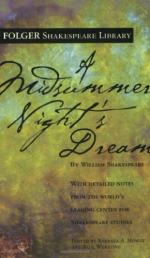|
This section contains 3,332 words (approx. 12 pages at 300 words per page) |

|
SOURCE: “The Chink in the Wall: Anticlimax and Dramatic Illusion in A Midsummer Night's Dream,” in Shakespeare Jahrbuch, Vol. 117, 1981, pp. 85-90.
In the following essay, Willson asserts that Shakespeare uses anticlimax in A Midsummer Night's Dream as a device that underlies the entire plot of the play.
The device of anticlimax dominates A Midsummer Night's Dream. A more appropriate word is “undercutting”, since anticlimax is identified so closely with bathos, or the descent of sense into nonsense. While there are numerous examples of poetic anticlimax in the comedy, and of pure bathos as well (“Pyramus and Thisbe” stands as a poetaster's delight), I am more interested in situations in which speakers and events threaten to move toward tragedy but are undercut by other words or events. A Midsummer Night's Dream certainly does not exhibit the melodrama associated with tragicomedy—I am not arguing for early Beaumont and Fletcher...
|
This section contains 3,332 words (approx. 12 pages at 300 words per page) |

|


